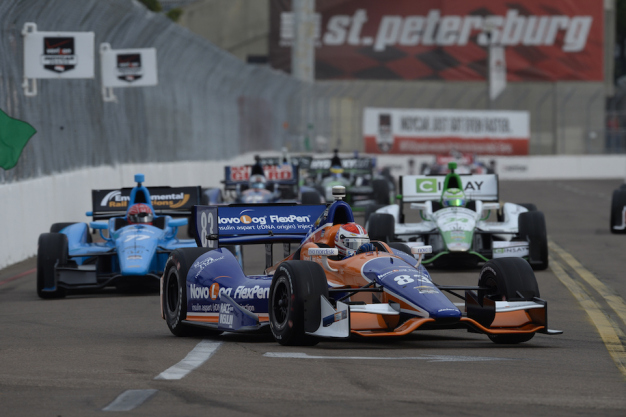Rulebook refinements ‘to make product better’
Via IndyCar.com
Double points awarded May 24 for the 99th Indianapolis 500 Mile Race and the Aug. 30 season finale at Sonoma Raceway are among the sporting and technical regulations that comprise the 2015 Verizon IndyCar Series rulebook issued to teams.
The 17-race season begins March 8 in Brasilia, Brazil, and the North American opener March 29 on the streets of St. Petersburg, Fla., will mark the competitive debut of distinctly different aerodynamic bodywork kits supplied by Chevrolet and Honda. Aero kit regulations, including homologation on Jan. 18, 2015, were previously issued to manufacturers by INDYCAR.
“The best thing the sanctioning body can provide competitors, manufacturers and fans is a stable, consistent rulebook, so most of the changes for 2015 are clarifying and tidying up definitions,” INDYCAR president of competition and operations Derrick Walker said. “The rulebook is a work in progress and we always look to refine it to make the product better.”
Will Power of Team Penske clinched the 2014 driver championship at Auto Club Speedway – one of three 500-mile races on superspeedways that awarded double points. The series title has been decided in the final race the past nine years.
Highlights of the 2015 Verizon IndyCar Series rulebook:
10.6.2.1. Double Points
Double race finish points are awarded for the Indianapolis 500 Mile Race and the last event of the season.
One-hundred points are awarded to the winner of a double-points race, with the runner-up receiving 80 points and the third-place finisher receiving 70 points. The scale decreases to 10 points for the 25th-place finisher and lower. Bonus points again will be awarded for leading the most race laps (two points) and leading at least one lap (one point). Outside of the Indianapolis 500, an entrant receives one point for earning the Verizon P1 Award. The Indianapolis 500 will rewards all entrants with points in its May 16-17 multi-tiered qualifications, including an additional nine points to the Verizon P1 Award winner.
“We look at the new calendar and analyze how many cars would be in contention for the championship after certain events, and the best trend with multiple cars racing for the championship was weighting it for the final race and the Indy 500, which is a special race deserving of double points,” Walker said.
6.2.1.Test Days
The 2015 testing days will be made up of the following: Engine Manufacturer Tests, Team Tests, Promoter Tests, and Full Size Wind Tunnel Tests.
Teams will be charged four days from their 14-day test allocation for Promoter Days (formerly known as Open Tests) at Barber Motorsports Park (March 16-17, for the introduction of Chevrolet and Honda street/road course aero kits), St. Petersburg (March 27), NOLA Motorsports Park (April 10), the Indianapolis Motor Speedway oval (May 3), the Indianapolis Motor Speedway road course (May 7), and Mid-Ohio Sports Car Course (July 31). The on-track Promoter Day at St. Petersburg, NOLA Motorsports Park, the Indianapolis road course and Mid-Ohio immediately precede the race event weekends.
“We see these days, working with the promoters, as a way fans can see the stars and cars in ways that aren’t available during the race weekend,” Walker said. “It will be a less formal day for the teams and drivers with long on-track sessions. Also, when you look at the schedule, there aren’t too many days that teams can test with the arrival of aero kits. We picked a nominal amount of dates to start to create value and cost-savings for teams.”
On-track testing is not permitted within seven before the start of on-track activity at a race location with the exception of the period March 9-25. Team testing blackout dates include Dec. 22-Jan. 4, 2015; Jan. 27-30; May 4-25.
To read more, please click here.

Photo courtesy of LAT Photo USA.


















